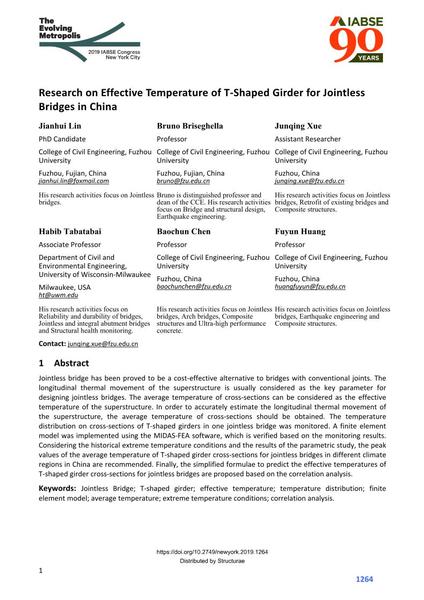Research on Effective Temperature of T‐Shaped Girder for Jointless Bridges in China

|
|
|||||||||||
Bibliografische Angaben
| Autor(en): |
Jianhui Lin
(College of Civil Engineering, Fuzhou University)
Bruno Briseghella Junqing Xue (College of Civil Engineering, Fuzhou University) Habib Tabatabai (Department of Civil and Environmental Engineering, University of Wisconsin‐Milwaukee) Baochun Chen (College of Civil Engineering, Fuzhou University) Fuyun Huang (College of Civil Engineering, Fuzhou University) |
||||
|---|---|---|---|---|---|
| Medium: | Tagungsbeitrag | ||||
| Sprache(n): | Englisch | ||||
| Tagung: | IABSE Congress: The Evolving Metropolis, New York, NY, USA, 4-6 September 2019 | ||||
| Veröffentlicht in: | The Evolving Metropolis | ||||
|
|||||
| Seite(n): | 1264-1268 | ||||
| Anzahl der Seiten (im PDF): | 5 | ||||
| DOI: | 10.2749/newyork.2019.1264 | ||||
| Abstrakt: |
Jointless bridge has been proved to be a cost‐effective alternative to bridges with conventional joints. The longitudinal thermal movement of the superstructure is usually considered as the key parameter for designing jointless bridges. The average temperature of cross‐sections can be considered as the effective temperature of the superstructure. In order to accurately estimate the longitudinal thermal movement of the superstructure, the average temperature of cross‐sections should be obtained. The temperature distribution on cross‐sections of T‐shaped girders in one jointless bridge was monitored. A finite element model was implemented using the MIDAS‐FEA software, which is verified based on the monitoring results. Considering the historical extreme temperature conditions and the results of the parametric study, the peak values of the average temperature of T‐shaped girder cross‐sections for jointless bridges in different climate regions in China are recommended. Finally, the simplified formulae to predict the effective temperatures of T‐shaped girder cross‐sections for jointless bridges are proposed based on the correlation analysis. |
||||
| Stichwörter: |
Temperaturverteilung Finite-Elemente-Modell
|
||||
